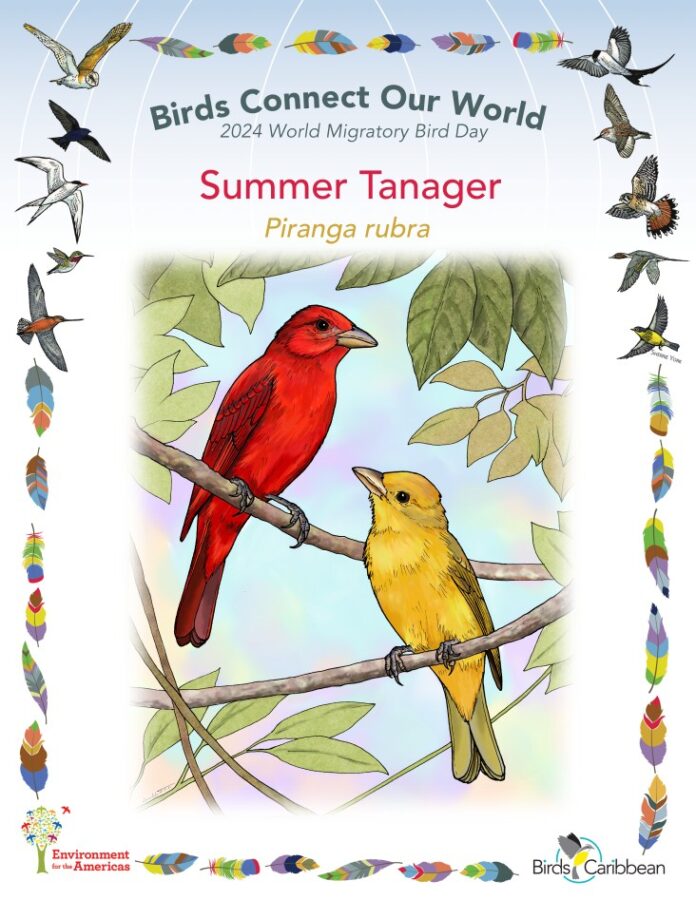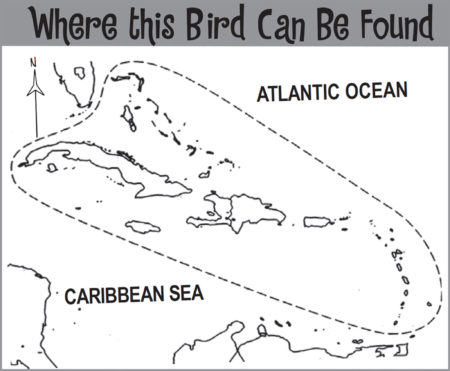Celebrate World Migratory Bird Day (WMBD) with us in 2024! This year’s theme is “Protect Insects, Protect Birds”. Have fun learning about a new migratory bird every day. We have coloring pages, interesting facts, activities, and more. Download for free and enjoy nature with your family at home.
Migratory Bird of the Day: Summer Tanager
Summer Tanagers are one of our boldest and brightest migratory birds, and they come in three exciting “flavors”! Look for them in an entirely bright red plumage or what we like to call strawberry (adult male), a warm yellow plumage better known as banana (adult female), and finally, a mixture of reds and yellows AKA strawberry-banana (young males and older females)!
Despite this buffet of colors, like many birds, Summer Tanagers were named after the appearance of the male. Their latin name, Piranga rubra, is a combination of the Tupi (a language native to Brazil) word for “bright red,” and the Latin word for “red.” Their name essentially means “bright red red” — a perfect description for the male’s stunning plumage!
These striking beauties breed in many parts of the Southern United States. However, there are two distinct breeding populations that likely each take different migration routes. Birds breeding in the Southwestern US migrate through Mexico, down into Central America, and even to northern South America. Birds breeding in the Southeastern US migrate through the Caribbean — Summer Tanagers have been recorded migrating through Cuba, The Bahamas, Dominican Republic, Jamaica, Barbados, Grenada, and Curacao. Whilst the majority will continue on to South America, some birds have been recorded overwintering in the Caribbean!
Like many other songbirds, Summer Tanagers prefer to migrate at night. Cooler temperatures help them avoid overheating during long flights, calmer nighttime air provides smoother flying conditions, and traveling under the cover of darkness means that they can avoid predators that hunt during the day. These birds sometimes flock together, forming groups of up to 30 individuals before leaving to their next stopover site. Flocking may help birds navigate and better avoid predators on the move.
Their rest and refuel time is spent gorging on the good stuff — flying insects like bees, wasps, and beetles, crunchy grasshoppers, and gooey caterpillars. Much like their strawberry and banana plumage, Summer Tanagers are also big fans of fruit, and they can often be found munching on mulberries, blackberries, citrus, and bananas. These crucial meals help them build muscle and fat reserves prior to taking off — in fact, in a study looking at weights and fat storage of migratory birds in the tropics, Summer Tanagers arriving in Panama in the fall were estimated to have enough fat to continue another 860 km of flying!
Summer Tanagers are ready to take summer with them, they are one of the earlier migrants detected migrating as early as August and arriving to their overwintering grounds by the end of September! During migration, look for these birds in secondary growth forests, with a preference for edge habitats and gardens. Their overwintering habitat is similar and they can often be found in forest edges and second-growth woodlands such as those used in shade-grown coffee plantations. You may spot them anywhere from low-lying mangroves, up to 1800 m in elevation!
If you’re fortunate enough to live on an island that serves as a migration stop for the Summer Tanager, you can attract these beautiful birds to your backyard by planting native trees that provide a rich source of flying insects and produce the fruits they love to feast on. This will help sustain these tanagers on their journey to South America. Learn more about this species, including its range, photos, and calls here. Great news! If you’re in the Caribbean, thanks to BirdsCaribbean, you have free access to Birds of the World and you can find out even more in the full species account of this bird!
Thanks to Holly Garrod for the text and Arnaldo Toledo for the lovely illustration!
Color in the Summer Tanager
Download the Migratory Birds of the Day Coloring Page! Use the picture above and the photos on this page as your guide, or look up pictures of the bird online or in a bird field guide if you have one. Share your colored-in page with us by posting it online and tagging us @BirdsCaribbean #WMBD2024Carib
Listen to the calls of the Summer Tanager
The calls of the Summer Tanager are a short, descending “pit-a-tuck.”
Enjoy these photos of Summer Tanagers
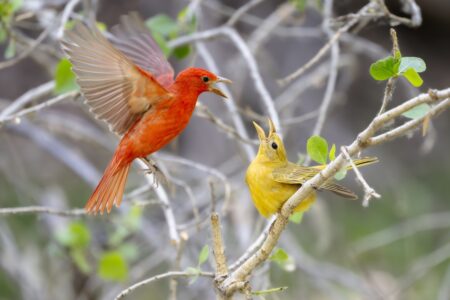
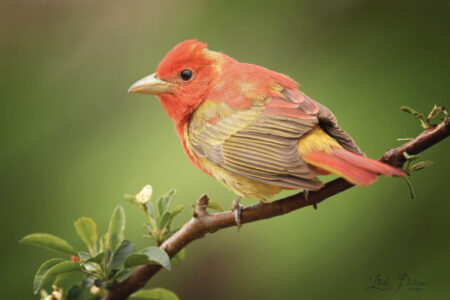
Activity of the Day
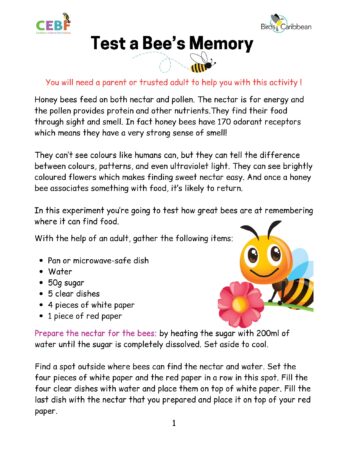 FOR KIDS: Honey bees feed on both nectar and pollen. Nectar provides energy, and pollen provides protein and other nutrients. They find their food through sight and smell.
FOR KIDS: Honey bees feed on both nectar and pollen. Nectar provides energy, and pollen provides protein and other nutrients. They find their food through sight and smell.
In today’s activity you will do an experiment to test how great bees are at remembering where they can find food!
With the help of an adult, you will need to gather the following items before you get started:
- Pan or microwave-safe dish
- Water
- 50g sugar
- 5 clear dishes
- 4 pieces of white paper
- 1 piece of red paper
Then download and follow these simple instructions and get started finding out more about bees!
FOR KIDS AND ADULTS: Enjoy this video of a male Summer Tanager feeding on fruit!

